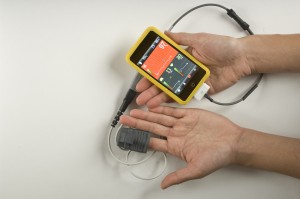Over five billion cell phones are now scattered across the globe. Integral to our daily lives, cell phones are used to make calls, to send messages, even to access the internet – but could they be used to diagnose potentially life-threatening conditions in pregnant women?
This is the bold idea of Dr. Mark Ansermino and Dr. Peter von Dadelszen from the University of British Columbia (UBC).
This unconventional pair – a pediatric anesthesiologist trained in health informatics and an obstetrician – received a grant from the Saving Lives at Birth partnership. The innovators are using their funds to create a mobile phone application that can identify women who are likely to develop dangerous complications to pre-eclampsia (high blood pressure associated with pregnancy).

Pre-eclampsia is surprisingly common, occurring in about 10% of pregnancies. For many women, the condition has few negative effects. For others, however, pre-eclampsia can lead to serious complications that threaten the lives of both mother and child. With no known cure, pre-eclampsia is the second leading cause of the approximately 360 000 maternal deaths that occur globally each year.
The only “treatment” for pre-eclampsia is delivery of the baby. In countries like Canada, women with the condition can often deliver their babies prematurely, and the babies will receive special care. In areas of the developing world, however, proper care for premature babies is not always available, so women are advised to continue the pregnancy for as long as possible. Of course, this puts the women at risk. So the question remains: which women will be able to carry their babies to term, and which may need to deliver prematurely in order to avoid serious complications as a result of pre-eclampsia?
The answer, Dr. von Dadelszen has discovered, can be found by using a non-invasive test for oxygen saturation in pregnant women. Normally, 97-100% of blood flowing through the body contains oxygen. In conjunction with other clinical signs and symptoms, when this number drops below 93%, it can indicate complications to pre-eclampsia, and the prediction can be made up to a week before these complications develop.
Upon making this groundbreaking discovery, Dr. von Dadelszen teamed up with Dr. Ansermino, who had previously designed the world’s first cell phone application to measure oxygen saturation. The two doctors are now working together to combine their products into a diagnostic application. “I think the most fantastic part,” says Dr. Ansermino, “has been the ability to work with another research team that comes from a totally different culture and environment. This is true multi-disciplinary collaboration.”

The team envisions that community health workers in rural areas will use the phone application to identify pregnant women who are likely to develop pre-eclampsia complications. The health workers can then take preventative measures to ensure that these women access the special care they need.
Just six months into their project, the innovators have already designed a stable software application and are preparing to embark on their first usability study.
Of course, it hasn’t always been smooth sailing for the team. “I think the biggest challenge with these sorts of projects is always the distance,” remarks Dr. Ansermino. “The people who need this product most are far away and this presents a big challenge.”
In addition to designing the application itself, Dr. Ansermino is also concerned about ensuring that the product is accessible around the globe. “We’ve done a lot of work from the technical side on how we can make this an ultra-low cost device,” he says.
The doctors hope that the accessibility, affordability, and portability of this innovative product will ensure its rapid uptake in rural communities, saving the lives of mothers and infants around the world.
Truly a bold idea with big impact in women’s and children’s health.
For more information, please visit: http://savinglivesatbirth.net/summaries/37.
− Kaitlyn Shannon (@KaitShannon)



